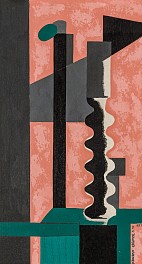BIOGRAPHY

German-American, 1888-1963
In American art circles in the second decade of the twentieth century, Cramer was an early emissary of European modernism. Born in Wurzburg, Germany, in 1888, Cramer studied art at the Karlsruhe Academy from 1906 to 1908 and with Ernest Schurth in the following year. He moved to Munich in 1910 and he began to see works by Europe's foremost cubist painters, Pablo Picasso and Georges Braque. He lived in Munich in the months leading up to the emergence of the Blaue Reiter group and found inspiration in the work and ideas of Wassily Kandinsky, Franz Marc, and others. The Blaue Reiter artists felt one must break with tradition and paint from "inner necessity." They believed that realistic representation of the world was no longer the sole aim of art-instead, expression of one's emotional responses to the world took precedence. These emotional qualities found expression in abstract forms and shapes and strong colors.
Cramer brought this philosophy with him when he he immigrated to the U.S. in 1911 and was an emissary of modernism to many of the artists he met, especially in the Woodstock Artist Colony where he settled.
Many of Cramer's paintings from his first decade in America are almost purely abstract-he began a pioneering series of non-objective paintings before the important Armory Show of 1913. Konrad Cramer's works from this early period are of immense relevance to the development of American Modernism. His work in the ensuing years would became influenced by the growing Modernist community around Stieglitz's 291 and in the artist colony at Woodstock. The brisk and fertile years marked by Cramer's arrival in the United States is among his most sought-after periods.
